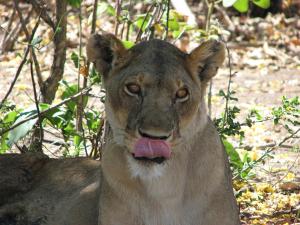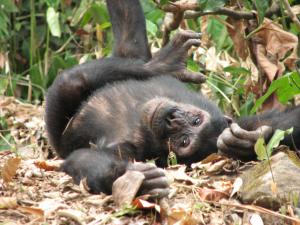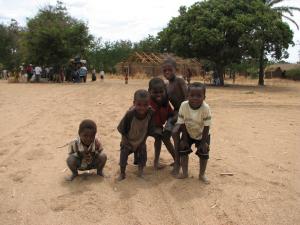For over half a year, I have abstained from writing this article, because of a strong feeling that I shouldn't. Just as a good guidebook may omit a local hangout spot to keep it from being overrun by tourists, I kept thinking that perhaps not telling anyone about our experience in western Tanzania was the right thing to do. The reason wasn't that I was selfishly hoping to keep visitors out of Mahale and Katavi. Let me explain.
These national parks are a world apart from…
There is good reason to try and conceal from everyone what the above two places are like. The national parks of Mahale Mountains and Katavi are a world apart from the most famous safari destinations such as Ngrongoro and Masai Mara. The key difference isn't in the landscapes or wildlife; it's in the number of visitors. Serengeti sees over 300,000 safarians each year; Katavi, about 1,000 (with half of them local Tanzanians). These two orders of magnitude have serious consequences. In the peak of the tourist season in Ngrongoro, up to 80 SUVs may descend onto a single poor cheetah, turning the whole experience into something like a zoo. In contrast, during our six days in Katavi, we would get excited if we saw another vehicle in the distance; cars being rarer and harder to spot than elephants or giraffes.

 Lioness in Katavi National Park
Lioness in Katavi National Park
Seldom visited doesn't mean undeserving; it just means hard to get to. Because we went in October, at the very end of the dry season, it seemed as if all the big animals in Katavi had congregated by the remaining water pools. We camped a few feet from the bank of one such pool with hundreds of hippos squeezed into it. During the night, they would come out and walk miles in search of grass to eat, periodically brushing against our tents and waking us up. (As long as you're inside a tent, most animals ignore you. The only time we really freaked out was when an elephant was munching on the branches of the tree that our two tents were next two.) Unlike the typical 40-mile game drives in search of wildlife in Serengeti, our longest was five miles; animal density is so high. Often we'd skip a drive altogether and watch the amazing animal theater from our camp site.
One of the people in my group, publisher of Russia's premier nature magazine, returned to Africa with a group of his own, two months ago. This time, he spent two weeks in all the parks of Kenya. He told me that after that, nothing compares to the density of animals we witnessed in Katavi National Park.

 An hour with chimpanzees, Mahale Mountains National
Park
An hour with chimpanzees, Mahale Mountains National
Park
If Katavi is remote and seldom-visited, Mahale is more so. There are no roads, paved or dirt, leading to this park. The only options for getting there are by plane or boat. Most people come to Mahale for chimp trekking, but I chose this destination for our group, based on Lonely Planet's descriptions; it being a destination farthest removed from the madness of Serengeti. I picked it because I wanted to sail down Tanganyika on a 1913 German-built mvLiemba ferry ($45.00 for a cabin, compared to $1,000.00 by charter plane). In fact, I was afraid that chimpanzee-trekking is a bit like bird-watching – something you really have to be into to enjoy. But now, having observed the chimpanzees in the jungle, I confess that this experience alone, makes Mahale Mountains National Park a treasure.
I've seen chimpanzees in zoos before, but peeking into their world for an hour is a different experience. It is jolting, awe-inspiring, mesmerizing. We still have recurring dreams from this encounter. I wouldn't blame anyone who has been to Mahale and Katavi for trying to keep it a secret, however, that is not what has been preventing me from writing. I know how important national parks are for wildlife conservation. I realize how much thought the Tanzania Wildlife Authority puts into determining park quotas. I'm not afraid of Mahale being overrun by tourists and negatively impacting the chimpanzees. I have no fear that Katavi will become the next Ngorongoro circuit. What has really been paining me is the striking effect of tourism on the local Tanzanians.
In planning our trip, I talked to numerous people who had visited Kenya or Tanzania. The consensus from all was that I should brace myself to be taken advantage of every step of the way. "Everyone expects something from you" and "They see you as a dollar, not as a person" were typical comments. I was ready for the worst, but the two weeks in western Tanzania were a constant pleasant surprise after pleasant surprise in our interaction with the locals.
Striking effect of tourism on the local Tanzanians
The markets in Kigoma and Mpanda, the day on the Liemba, the time in the villages of Sitalike and Ikola – over and over we came across helpful, proud, amazing people. No one asked us to pay for pictures, but time and time again, people asked us to take a picture of them. Kids didn't beg for money or pens; they just followed us around in excitement, deliriously happy and laughing every time we would say something. We had time and opportunity to talk to adults; there was sincere interest on both sides. Not once did anyone try to sell us something at the end of a chat. These may seem like simple things, however, they are a stark contrast to our ten days in Zanzibar, where all the negative warnings I heard from ex-travellers turned out to be true.

 Children in the Ikola village on the shores of Lake
Tanganyika
Children in the Ikola village on the shores of Lake
Tanganyika
It's hard to capture the experience of wandering around a village with these kids around me; teaching me how to count in Swahili, laughing at my mistakes.
I decided to write about my experiences because I realize that up is the only direction in which visitor numbers can move; I would not wish the opposite on any region. I suspect and hope that BootsnAll readers will travel to western Tanzania in a way that minimizes, if not altogether avoids, negative impacts on the local culture. One couple from New Zealand, managing a luxury camp, told us they once received a complaint from a disgruntled guest, "I didn't realize there would be so many black people around". A journey on the Liemba ferry is not the right option for a person like that.
The logistics
If you can spend $600.00 per person per night, travel arrangements are probably easy. We brought our own tents and cooked our own food, so there was no money to be made on us. That resulted in months of futile attempts on my part to find out: which day of the week Liemba sails to Mahale, if there are scheduled reasonable flights from Dar to Kigoma, whether you need to bring water with you to Katavi camp sites, and so on. No safari operators ever bothered to write back to me. Different forum posts where I begged for information, resulted in sincere warnings against attempting such a trip to Africa the first time. I was desperate.
This journey would not have happened if not for the miraculous help of Hussein Mgungah of Lipi Adventure Company. As I was about to give up on this itinerary, he came across one of my posts, e-mailed me, and promised to help. Not only is it hard to get answers for a foreigner, but even Hussein had to actually travel for two weeks to Kigoma to find out how to make this trip a reality. Turns out that everything is doable; all logistic problems have solutions. Two weeks in Mahale/Katavi are possible on a budget, not that far above a Serengeti and Ngorongoro visit.
If you are interested in visiting western Tanzania, I would be delighted to share everything I know. You can reach me through BootsnAll.